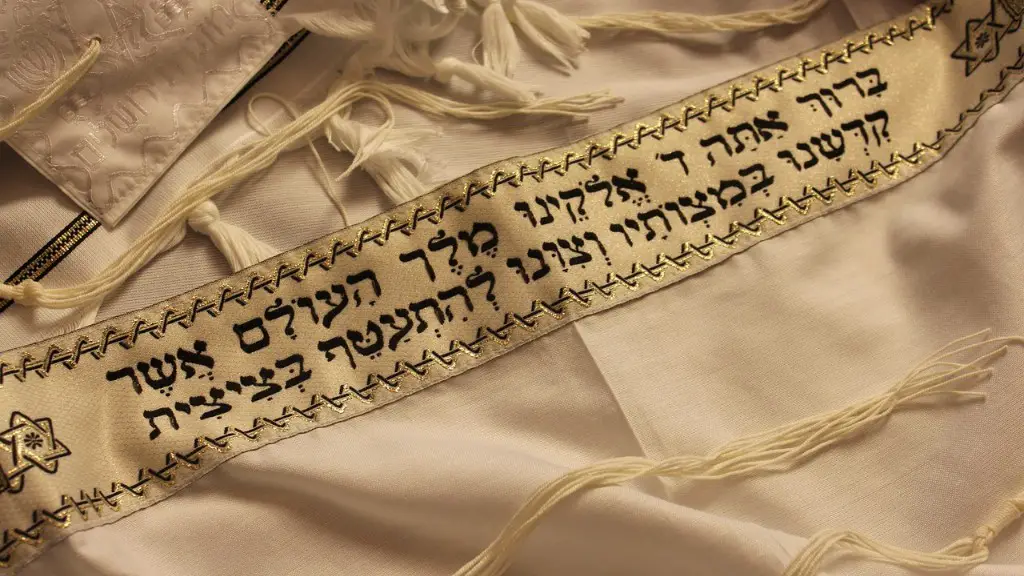The Holy Book of Judaism is called the Tanakh. It is an acronym for the three main divisions that compose the full Jewish religious text: the Torah, Nevi’im, and Ketuvim. The Torah, which means “teaching” or “instruction” in Hebrew, is the most sacred and foundational text for Jewish belief and practice. It is comprised of the first five books of the Hebrew Bible – Genesis, Exodus, Leviticus, Numbers, and Deuteronomy.
The Torah was written and compiled between the 12th and 2nd centuries BCE, though many portions were derived from earlier oral traditions that predate written history. It is attributed to several authors, including Moses, who is said to have followed a divine mandate and transcribed God’s words onto the tablets of Moses. The Tanakh also includes Nevi’im, which is the second of the three divisions and made up of prophetic books written between the 8th and 2nd centuries BCE. The prophetic books contain stories, ceremonial instructions, and insight about the nature of God and God’s relationship to human beings.
The final division of the Tanakh, Ketuvim, encompasses a wide range of literary forms. It includes psalms, hymns, and poetic works like the Book of Job, as well as wisdom literature, histories, and prophetic texts. Despite the divergent sources, authors, and styles of the texts, there is a common thematic thread throughout the Tanakh: God revealed moral and ethical codes to humans, who, though imperfect, strive to uphold them.
The books of the Tanakh are not ordered chronologically, but rather thematically. They reflect a variety of perspectives, including joy and sorrow, love and hate, stark realism, and inspiring optimism. The books of the Tanakh provide Jews with a living document of their shared history, faith, and traditions. They offer a glimpse into the past and serve as a compass to help Jews remain faithful to their identity in the present and future.
Judaism vs Christianity Holy Books
Different religions have different holy books that form the basis of their beliefs and practices. By way of comparison, Christianity’s primary holy book is the Bible, which incorporates two individual texts: the Old Testament and the New Testament. While both the Tanakh and the Bible largely overlap in terms of content, Jews and Christians interpret these texts differently and derive different beliefs and teachings from them. For example, Jewish scripture does not include stories such as the virgin birth of Jesus, which is a central tenet of Christianity.
The Tanakh is referred to as the Hebrew Bible in Christian denominations, but it excludes several books known as the Apocrypha, which are considered canonical by some Christian denominations although not by Jews. Jews cite the Rabbinical Oral Law and the Mishnah as additional scripture, although these do not form part of the Tanakh. In other words, the Tanakh is not the entirety of Jewish scripture, but rather a part of it.
The Significance of the Tanakh
For Jews, the Tanakh serves as the ultimate source of faith and truth. It is both a record of their ancestral journey with God and a foundation for their religious practice in the present day. Jews draw lessons from the Tanakh and strive to exemplify its moral frameworks in their daily lives. The Tanakh is also an essential tool in Jewish community life, providing guidance on laws, rituals, and celebrations. In studying the Tanakh, Jews open themselves to deeper understanding of their past and the unfolding of their destiny.
The Tanakh and Jewish Identity
In addition to providing emotional and spiritual sustenance, the Tanakh is an integral source of identifications for Jews across the world. It serves as a bridge between the various sects and denominations, representing endearing commonalities. By connecting to the texts and stories of the Tanakh, Jews of all backgrounds can gain pride in their shared heritage and cultural continuity, which originates in the covenant between God and the Jewish people.
The Text of the Tanakh
The Tanakh is written in Hebrew, a language many Jews still speak today. The Tanakh is composed of Hebrew characters and is also written from right to left. Every time a Jew opens and reads from a Tanakh, they experience a powerful connection to their rich heritage. As they interpret its stories and teachings, they gain insight into their past, present, and future.
The Study of the Tanakh
The Tanakh is not simply a book of religious stories and laws. Scholars, rabbis, and other religious leaders often engage in detailed and analytical study of the Tanakh in order to uncover new lessons and meanings. This practice, known as parshanut, often reflects the changing circumstances of the Jewish people and reveals unique insights and interpretations. The study of the Tanakh is an essential part of Jewish tradition and the development of religious thinking.
Point of View in Tanakh
The Tanakh is a collection of texts written by authors from different times and places, and it reflects a wide range of views. Though authors often portray God and other characters in a positive light, the texts also acknowledge human suffering and complexity, as well as the contradictions of social customs and ideology. Some authors may even contradict one another, suggesting that readers should not take any single perspective on faith and morality for granted. By considering the range of voices in the Tanakh, readers enrich their understanding of Jewish faith and history.
Modern Application of the Tanakh
The lessons found in the Tanakh remain relevant in the modern age. Jews continue to look to the Tanakh for ethical principles, life guidance, and spiritual solace. Scholars and religious leaders often refer to its timeless wisdom when seeking answers to questions of belief and practice. In this way, the Tanakh functions as the cornerstone of Jewish faith, providing a sense of continuity and structure for the Jewish people throughout the ages.
The Role of Rabbis in the Tanakh
Rabbis are at the heart of Jewish culture and tradition. They pass down the knowledge of the Tanakh and other sacred texts to new generations, stimulate meaningful spiritual conversations, and create an environment of learning and discovery. The role of the rabbi is to interpret ancient texts and apply them to current times, thereby making the wisdom of the Tanakh accessible to new audiences. With the help of rabbis, Jews around the world can access the depths of Jewish faith and tradition and gain insight into the ongoing conversations and debates that surround the Tanakh.


